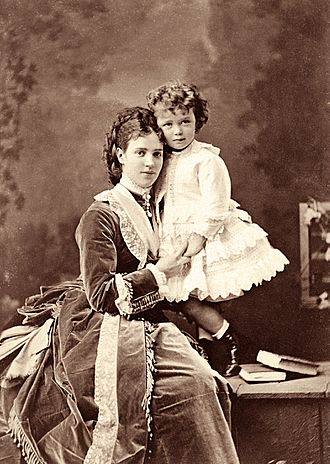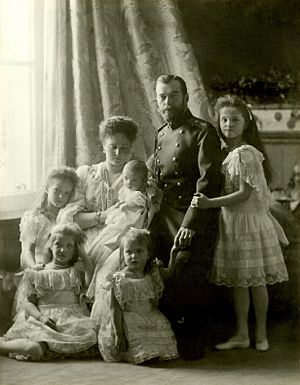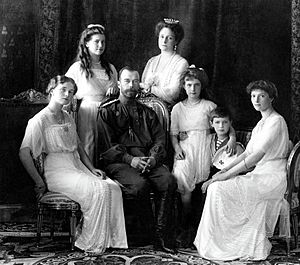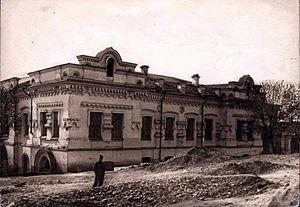Nicholas II of Russia facts for kids
Quick facts for kids Nicholas II |
|||||
|---|---|---|---|---|---|
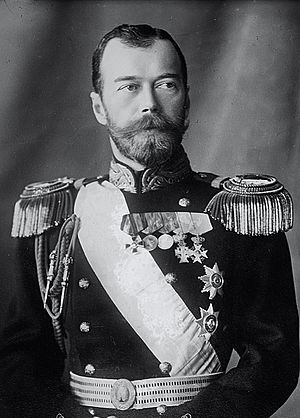
Nicholas II in 1912
|
|||||
| Emperor of All Russia | |||||
| Reign | 1 November 1894 – 15 March 1917 | ||||
| Coronation | 26 May 1896 | ||||
| Predecessor | Alexander III | ||||
| Successor | Monarchy abolished Georgy Lvov (as Minister-Chairman) |
||||
| Prime Minister | See list | ||||
| Born | 18 May [O.S. 6 May] 1868 Alexander Palace, Saint Petersburg, Russian Empire |
||||
| Died | 17 July 1918 (aged 50) Ipatiev House, Yekaterinburg, Russian Soviet Republic |
||||
| Burial | 17 July 1998 Peter and Paul Cathedral, Saint Petersburg, Russian Federation |
||||
| Spouse | |||||
| Issue | |||||
|
|||||
| House | Holstein-Gottorp-Romanov | ||||
| Father | Alexander III of Russia | ||||
| Mother | Maria Feodorovna (Dagmar of Denmark) | ||||
| Religion | Russian Orthodox | ||||
| Signature |  |
||||
| Saint Nicholas II of Russia | |
|---|---|
 |
|
| Passion-Bearer | |
| Venerated in | Eastern Orthodoxy |
| Canonized |
|
| Major shrine | Church on Blood, Yekaterinburg, Russia |
| Feast | 17 July |
Nicholas II (born 18 May 1868 – died 17 July 1918) was the last Emperor of Russia. He ruled from 1894 until he gave up his throne in 1917. In the Russian Orthodox Church, he is known as Saint Nicholas the Passion-Bearer.
After he stepped down as emperor, Nicholas and his family were held captive. They were first held by the Russian Provisional Government and later by the Bolsheviks. In July 1918, Nicholas and his family were executed.
Years later, in 1981, Nicholas, his wife, and their children were recognized as martyrs by the Russian Orthodox Church Outside Russia. Their burial site was found in 1979, but it wasn't officially confirmed until 1989. After the fall of Communism, their remains were identified using DNA. They were reburied in a special ceremony in St. Petersburg on 17 July 1998. In 2000, the Russian Orthodox Church made them saints.
Contents
Early Life of Nicholas II
Nicholas was born on 18 May 1868, at the Alexander Palace near Saint Petersburg. His grandfather, Alexander II of Russia, was the emperor at the time. Nicholas was the oldest child of Alexander III of Russia and his wife, Maria Feodorovna (Dagmar of Denmark).
He was given the traditional Romanov name "Nicholas." People close to him often called him "Nikki."
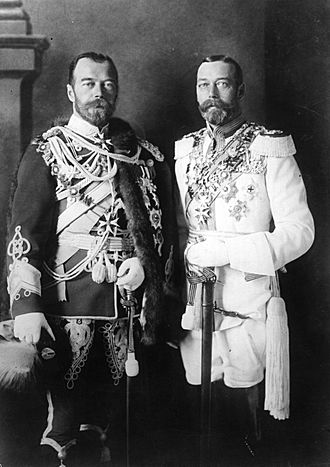
Nicholas had family connections to many kings and queens across Europe. His mother's siblings included kings of Denmark and Greece, and Queen Alexandra of the United Kingdom. Nicholas, his wife Alexandra, and Wilhelm II, German Emperor were all cousins of King George V of the United Kingdom.
In 1881, after his grandfather Tsar Alexander II was assassinated, Nicholas became the heir to the throne. His father, Alexander III, became the new emperor.
In 1884, Nicholas had a special ceremony where he promised loyalty to his father. Later that year, he met Princess Alix, a granddaughter of Queen Victoria. Nicholas and Alix fell in love. In 1894, they became officially engaged. Nicholas's parents agreed to the marriage when they saw that Tsar Alexander's health was getting worse.
Nicholas and Alix got married on 26 November 1894.
Becoming Emperor of Russia
When his father, Alexander III, died at 49, Nicholas became the Emperor of Russia. He was only 26 years old.
Nicholas felt he wasn't ready to be emperor. He even asked his cousin, "What is going to happen to me and all of Russia?"
Nicholas decided to continue many of his father's policies. He supported some economic changes but didn't want the new parliament, called the Duma, to have too much power. His desire to keep all power for himself, along with military defeats, weakened his rule.
By March 1917, people no longer supported Nicholas. He was forced to give up his throne, which ended the 300-year rule of the Romanov dynasty in Russia.
Nicholas signed an agreement in 1907 with Britain. This agreement helped end conflicts between Russia and the British Empire. He also tried to promote peace and disarmament through international meetings. However, he faced criticism for how his government dealt with opponents. His popularity also suffered after Russia lost the Russo-Japanese War.
During the July Crisis in 1914, Nicholas supported Serbia. He ordered the Russian Army to prepare for war. Because of this, Germany declared war on Russia, starting World War I. Russia suffered huge losses in the war, which led to a collapse of morale. A large strike and a military uprising in Petrograd led to the February Revolution. This caused the monarchy's power to crumble.
Giving Up the Throne
At the end of the "February Revolution", Nicholas II decided to give up his throne on 15 March 1917. He first wanted his son, Alexei, to become the next emperor. However, doctors advised him that Alexei might not live long if separated from his parents. So, Nicholas changed his mind.
He then named his brother, Grand Duke Michael, as the next emperor. But Michael refused to accept the throne unless the people voted for it. This decision by Nicholas II and Michael ended the Romanov dynasty's 300-year rule. The end of the Tsar's rule brought mixed feelings in Russia, including joy, relief, and confusion.
Being Held Captive
On 20 March 1917, the new government ordered the imperial family to be held under house arrest at the Alexander Palace. Later, due to unrest, it was decided to move the family to a safer place. Alexander Kerensky, the prime minister, chose Tobolsk in Western Siberia. It was a remote town far from any big cities.
The family arrived in Tobolsk on 19 August. They lived in the former Governor's Mansion and were quite comfortable.
Nicholas and Alexandra were upset by news of the Treaty of Brest-Litovsk. This treaty meant Russia had to give up a lot of land. The family kept their spirits up by believing that help was coming. They thought there were plans to rescue them. However, after Russia left the war, other countries lost interest in the Romanovs' fate.
When the Bolsheviks took power in the October Revolution, the Romanovs were moved to Yekaterinburg. They were imprisoned in a two-story house called the Ipatiev House. The Bolshevik leaders decided to execute the Tsar and his family.
The Execution
Historians have different accounts of what exactly happened. According to the Bolshevik officer Yakov Yurovsky, the royal family was woken up around 2:00 AM on 17 July 1918. They were led to a basement room in the Ipatiev House. They were told it was for their safety because anti-Bolshevik forces were approaching.
In the basement, all members of the royal family were executed by a firing squad. Their doctor and three servants who chose to stay with them were also killed. These included the Tsar's doctor Eugene Botkin, his wife's maid Anna Demidova, the family's chef Ivan Kharitonov, and footman Alexei Trupp.
Finding the Remains
In 1979, the bodies of Tsar Nicholas II, Tsaritsa Alexandra, three of their daughters, and four non-family members were found near Yekaterinburg. An amateur archaeologist named Alexander Avdonin discovered them.
In January 1998, the remains were officially identified as Nicholas II and his family. However, one daughter (either Maria or Anastasia) and Alexei were missing. Scientists from Russia, Britain, and America used DNA analysis to confirm the identities. They even compared the DNA to a living relative.
In July 2007, more bones were found near Yekaterinburg. These belonged to a boy and a young woman. In April 2008, DNA tests confirmed these were the bones of Alexei and one of his sisters. This meant that the remains of the entire family had been found.
In 2008, the Supreme Court of Russia ruled that Nicholas II and his family were victims of political persecution. In 2015, at the request of the Russian Orthodox Church, the bodies of Nicholas II and Alexandra were re-examined. This further confirmed their identities.
The Funeral
After the DNA tests in 1998, the remains of the Tsar and his family were buried at St. Peter and Paul Cathedral in Saint Petersburg. The burial took place on 17 July 1998, exactly 80 years after their execution.
Russian President Boris Yeltsin attended the ceremony. He said, "Today is a historic day for Russia. For many years, we kept quiet about this monstrous crime, but the truth has to be spoken."
Nicholas II's Children
| Image | Name | Birth | Death | Notes |
|---|---|---|---|---|
| By Princess Alix of Hesse and by Rhine (6 June 1872 – 17 July 1918, married on 26 November 1894) | ||||
 |
Grand Duchess Olga Nikolaevna | 15 November [O.S. 3 November] 1895 | 17 July 1918 | Assassinated, along with their parents, at Yekaterinburg by the Bolsheviks |
 |
Grand Duchess Tatiana Nikolaevna | 10 June [O.S. 29 May] 1897 | ||
 |
Grand Duchess Maria Nikolaevna | 26 June [O.S. 14 June] 1899 | ||
 |
Grand Duchess Anastasia Nikolaevna | 18 June [O.S. 5 June] 1901 | ||
 |
Tsarevich Alexei Nikolaevich | 12 August [O.S. 30 July] 1904 | ||
Images for kids
-
Coronation of Nicholas II by Valentin Serov
-
Silver coin: 1 ruble Nikolai II_Romanov Dynasty – 1913 – On the obverse of the coin features two rulers: left Emperor Nikolas II in military uniform of the life guards of the 4th infantry regiment of the Imperial family, right Michael I in Royal robes and Monomakh's Cap. Portraits made in a circular frame around of a Greek ornament.
-
Nicholas II's opening speech before the two chambers of the State Duma in the Winter Palace, 1906.
-
One ruble silver coin of Nicholas II, dated 1898, with the Imperial coat-of-arms on the reverse. The Russian inscription reads: B[ozheyu] M[ilostyu] Nikolay Imperator i Samoderzhets Vse[ya] Ross[ii].[yskiy]. The English translation is, "By the grace of God, Nicholas II, Emperor and Autocrat of All the Russias."
-
Nicholas II, Stolypin and the Jewish delegation during the Tsar's visit to Kiev in 1911
-
Nicholas II and his son Alexei aboard the Imperial yacht Standart, during King Edward VII's state visit to Russia in Reval, 1908
-
Nicholas II (right) with Kaiser Wilhelm II of Germany in 1905. Nicholas is wearing a German Army uniform, while Wilhelm wears that of a Russian hussar regiment.
-
Russian prisoners after the Battle of Tannenberg, where the Russian Second Army was annihilated by the German Eighth Army
-
Nicholas II with his family in Yevpatoria, Crimea, May 1916
-
Nicholas II under guard in the grounds at Tsarskoye Selo in the summer of 1917.
-
Emperor Nicholas II Land in a 1915 map of the Russian Empire. At the time it was believed that what is now Severnaya Zemlya was a single landmass.
-
After his coronation, Nicholas II leaves Dormition Cathedral. The Chevalier Guard Lieutenant marching in front to the Tsar's right is Carl Gustaf Mannerheim, later President of Finland.
-
King Chulalongkorn of Siam with Nicholas II in Saint Petersburg, during the king's visit to Europe in 1897
See also
 In Spanish: Nicolás II de Rusia para niños
In Spanish: Nicolás II de Rusia para niños


